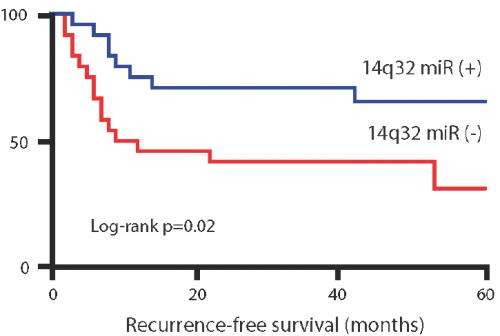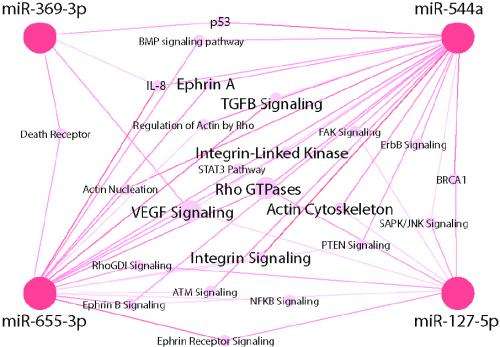MicroRNAs can limit cancer spread

Cancers that have spread throughout the body, a process known as metastasis, are difficult, often impossible, to control. They are the leading cause of cancer-related deaths.
Twenty years ago, however, two University of Chicago cancer specialists—Samuel Hellman, former dean of the University of Chicago's Division of the Biological Sciences, and Ralph Weichselbaum, chairman of radiation oncology—described what they considered an intermediate and potentially treatable state between a single tumor and widespread cancer. They labelled it oligometastasis.
Like oligarchy, the rule of the few, oligometastasis denotes a stage of cancer in which a primary tumor has spawned only a few localized secondary tumors, typically no more than five. The two researchers, nationally recognized authorities on radiation therapy for cancer, suggested and subsequently proved that oligometastatic tumors could often be cured with targeted local treatment such as surgery or focused radiation.
In the February, 2015, issue of the journal Oncotarget, Weichselbaum, co-director of the Ludwig Center for Metastasis Research at the University of Chicago, and colleagues present the first glimpse of the biological mechanisms behind oligometastasis.
They gathered genetic information from tumor samples from their own published clinical trials, the only known datasets of patients with oligometastases. They used this information to identify small clusters of gene-blocking microRNAs expressed only by oligometastatic cells. They also show how certain microRNAs can shut down specific genes, by attaching to their messenger RNA, essentially silencing them.

The researchers found that 14 of these microRNAs, including the most important ones, were encoded by a small chromosomal region known as 14q32. This region is important for early embryonic development. Mutations of genes found on 14q32 have been linked to several childhood diseases.
When the researchers studied the genes that these microRNAs suppressed, they found that many of them were involved in pathways that enabled cancerous cells to adhere to other cell types, invade tissues and migrate to distant sites, the hallmarks of metastasis.
"We call this the AIM phenotype," Weichselbaum said. Tumor cells that express certain microRNAs from 14q32 lack the ability to adhere, invade or migrate (AIM). Instead they give rise to a small number of less aggressive tumors, many of which are curable with local therapy."
The researchers suggest these microRNAs could provide a personalized biomarker, helping physicians predict how aggressively a tumor can spread. "We could use that knowledge to guide treatment," Weichselbaum said.
His team identified four microRNAs from the 14q32 cluster that correlated with a good prognosis. Overexpression of these four microRNAs was associated with a prolonged recurrence-free interval after surgical removal of secondary tumors. Sixty percent of 24 patients with elevated levels of these microRNAs had no metastatic recurrence after five years of follow-up. Seventy percent of 24 patients with low microRNA expression had a recurrence, usually within the first year.
Additional tests, using an animal model of human breast cancer that measures tumor spread to the lungs, confirmed the initial results. Three of the four microRNAs (miR-127-5p, miR-544a and miR-655-3p) suppressed the rapid growth of new lung tumors in immunocompromised mice injected via the tail with breast cancer cells.
They were able to trace some of the benefits to inhibition of specific genes. Blocking a gene called TGFBR2 suppressed cellular adhesion and invasion and reduced the number of lung metastases. Inhibiting ROCK2 suppressed invasion and also led to a decrease in metastasis number.
These findings, the authors conclude, "support our hypothesis of oligometastasis as a clinical entity with biological mechanisms and molecular properties that may differ from polymetastatic disease.... Our results set the stage for improved identification of patients with oligometastasis and guide the development of therapies to limit metastasis development.














